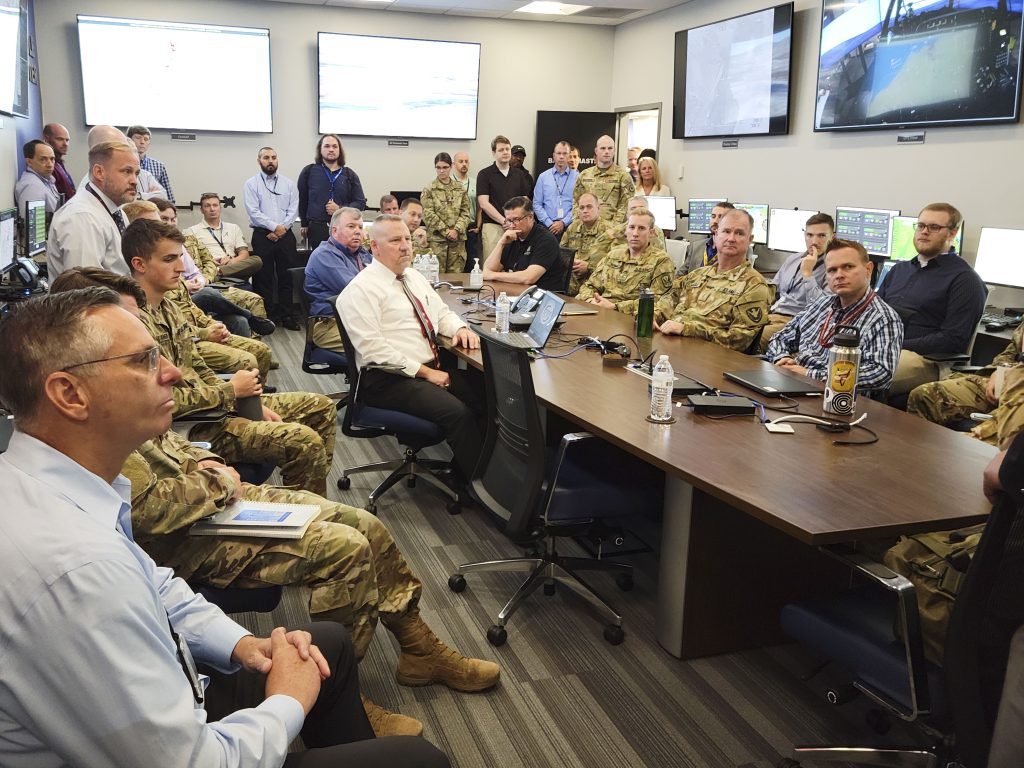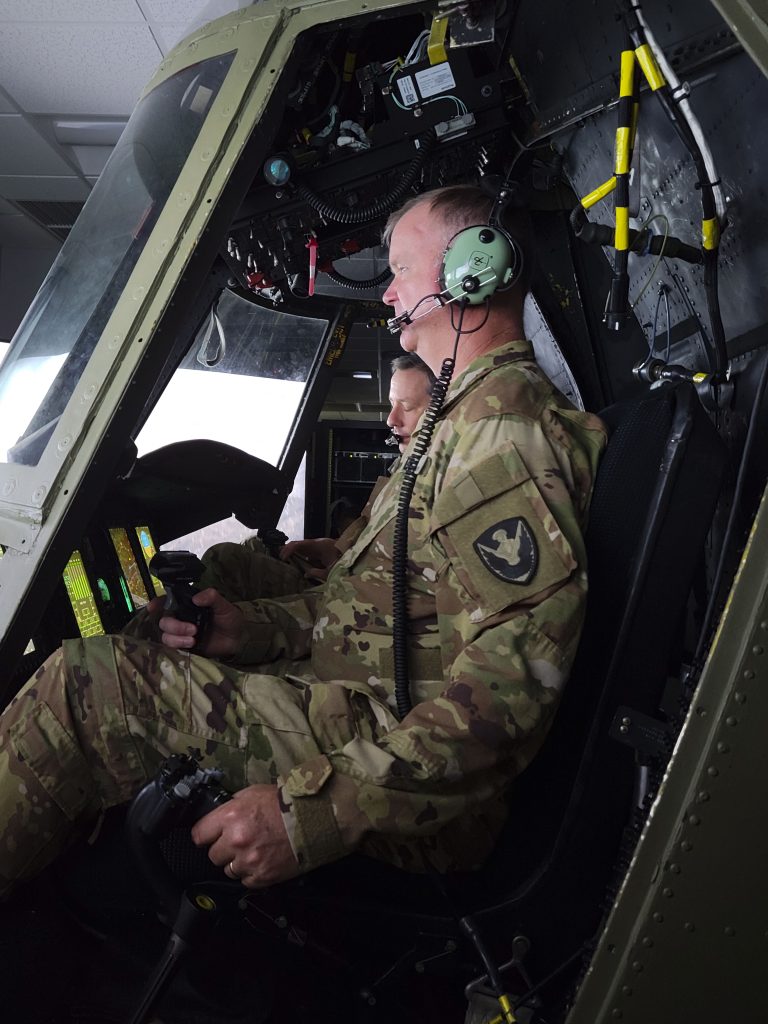
THIS IS JUST A TEST: An AH-64 Apache aircrew conducts a simulated mission in the Combat Aviation Brigade Architecture Integration Lab, Apache systems integration laboratory. A decommissioned Apache fueslage is used for the development, integration and testing of new systems. (U.S. Army photo)
The Combat Aviation Brigade Architecture Integration Lab enables Aviation warfighters and materiel developers to co-develop, integrate and examine maturing systems and capabilities and improve the force in a streamlined manner.
by Al Abejon
The Combat Aviation Brigade Architecture Integration Lab of the Program Executive Office (PEO) for Aviation on Redstone Arsenal, Alabama, houses a unique combination of advanced development and simulation capabilities for Army aviation. It blends multiple live, virtual and constructive simulations of manned and unmanned aircraft, air and ground mission systems and command and control, which together provide a comprehensive replication of an aviation force in a tailorable air-ground operations environment.
The laboratory enables a more streamlined and efficient means of exploration and experimenting with the evolving capabilities of maturing technologies in a risk-reduced, realistic setting. These activities demonstrate the impacts of technical advances on the capabilities of our current aircraft as well as influence the design, architecture and implementation of Future Vertical Lift aircraft. They also provide an initial understanding of resultant changes in the operational effectiveness of aviation as a collective force.
Established in December 2019, the Combat Aviation Brigade Architecture Integration Lab is a combination of interoperable, high-fidelity, current force, manned and unmanned aircraft systems integration labs, simulators and emulators. The need to demonstrate, test and validate system capabilities from a force perspective in a risk-reduced and cost-effective realistic operational environment is one of the driving concepts for the development of the laboratory. Rather than focusing on developing and exploring capabilities of an individual system or aircraft, this facility examines the resulting operational effectiveness of new capabilities across the total aviation formation.
“The lab is an excellent tool to conduct risk reduction evaluations on new technologies at a fraction of the cost of using actual aircraft,” said Robb Keeter, the laboratory’s senior program integrator and operations officer. “It allows the project managers to examine new aviation hardware and software in a realistic air-ground operations environment.”

BRIGADE BATTLE MASTER: The Combat Aviation Brigade Architecture Integration Lab’s Battle Master replicates the remainder of the aviation and ground forces to compliment the live and virtual simulators and establishes the simulated operational environment during testing scenarios. (U.S. Army photo)
AIR PLATFORMS INTEGRATED
The Combat Aviation Brigade Architecture Integration Lab contains Apache, Black Hawk and Chinook aircraft systems integration laboratories, Gray Eagle and Shadow unmanned aircraft systems ground control stations and an aviation tactical operations center. The systems integration laboratories consist of partial aircraft fuselages that have been re-purposed for engineering development to host mission systems and equipment of the actual aircraft. These systems integration laboratories are not flight simulators or training systems; rather, they are high-fidelity aircraft replications used to support the development, integration and modernization of aviation systems.
Planning, communications, navigation, weapons, sensors and many other systems are included for a total force perspective. Collectively, they are key in assessing the operational efficacy of new technologies on the operations of the Combat-Aviation Brigade as a maneuver force.
The Combat Aviation Brigade Architecture Integration Lab’s Battle Master is the central hub of the facility. It augments the virtual aircraft system-integration labs and replicates the rest of the aviation force through multiple constructive simulation stations that can be configured to emulate additional aircraft and their respective capabilities, as well as supported ground forces. The Battle Master also establishes the operational environment and injects effects such as rain, smoke, fog, artillery fires, close-air support, naval gunfire and ground threats.
APPROACHABLE OPEN SYSTEMS
Another important aspect of the Combat Aviation Brigade Architecture Integration Lab is the ability to explore and examine the application of modular open systems approach implementation techniques and standards in incorporating emerging technical solutions into aircraft. These standards promote commonality and standardization of hardware, software and data exchange aboard current and future aircraft. The laboratory contains multiple aircraft integration assets that can be used by the aviation project managers and industry partners to explore the use of established modular open systems approaches to standardize aircraft integration of communications, navigation, sensors, weapons and mission command systems. PEO Aviation’s Modular Open Systems Approach Transformation Office provides the guidance and direction for implementing this architecture approach across the aviation domain.
The laboratory is also able to replicate networks and information exchange capabilities of an aviation force maneuvering through an operational area. Compatible out-the-window visual systems and a common terrain database enable visual interoperability to include sharing of sensor video among the aircrews and actual communications equipment with replicated networks provide air-ground and air-air information exchange.
The systems integration laboratories, simulators, emulators and equipment in the laboratory are interoperable with each other and with other similar facilities such as the Army Research Laboratory locations at both Aberdeen Proving Ground, Maryland and the Ground Vehicle Systems Command in Michigan. The Combat Aviation Brigade Architecture Integration Lab employs an automated constructive simulation program known as One Semi-Automated Forces or OneSAF to create a common realistic operational environment in which simulated forces can operate together. A critical purpose of the laboratory and its systems is to participate in operational experimentations and to exchange critical mission planning and execution data with other labs in the Army and the other Joint Services.
The laboratory brings Soldiers in to participate in activities to provide user input and feedback on new technologies well before fielding begins. The exercises often include active duty, Army Reserve and National Guard Soldiers from various aviation-related career fields. The Soldiers provide current relevant input from all echelons of Army Aviation.
“The lab is helping determine what [capabilities] future aviators could get to further their situational awareness.” First Lt. Andrew Rines, a Black Hawk pilot with the Tennessee Army National Guard, commented after an event.

PRACTICE MAKES PERFECT: A Chinook crew conducts a simulated mission in the CH-47 systems integration laboratory. The Combat Aviation Brigade Architecture Integration Lab relies on Soldiers from all components to provide current, relevant input from all echelons of Army aviation. (U.S. Army photo)
ACTUAL COMBAT IS TOO LATE
The testing and development of aviation systems for use in a combat environment cannot wait until actual combat occurs. The Combat Aviation Brigade Architecture Integration Lab provides a highly relevant collective venue to rapidly pursue and evaluate new and emerging technologies along with mission command options and alternatives. Experiments and computer exercises in the laboratory help increase the effective flow of mission-command information as well as improving accurate and relevant situational awareness, command and control, adjudication of aerial fires, key logistics deliveries and life-saving medical support.
The focus of the Army’s operational doctrine has shifted from counter-insurgency operations over the past 20 years to large scale combat operations. This shift is highlighted by the conduct of operations at greatly extended ranges, in contested and uncontested environments, against a larger, highly sophisticated threat. The complexities of these types of operations in the Joint all-domain operational environment require the Army to execute the fight in an extended maneuver battlespace, conduct deep strike operations, operate as an element of a Joint force and ultimately prevail in all combat situations. The laboratory provides a means to rapidly develop and address the challenges of these changes in operational concepts using reduced manning and resources. It also supports continued modernization of the Army’s enduring aviation fleet while simultaneously influencing the establishment of Future Vertical Lift aircraft requirements, design and architecture.
CONCLUSION
Today’s Army exists and operates in a budget-constrained environment and it must be creative in maximizing the application of all available resources. The Combat Aviation Brigade Architecture Integration Lab provides a means by which warfighters and materiel developers can co-develop and examine systems and capabilities in a streamlined manner. It enables the warfighter to be equipped with operationally verified capabilities in an expedited manner with less risk and at reduced development costs. These concepts and attributes further ensure Army Aviation’s readiness and its ability to fight and win as a maneuver force of the Army’s Combined Arms Team and element of the Multi-Domain Task Force today and into the future.
For more information go to: http://army.mil/PEOAviation.
AL ABEJON is the director of the Combat Aviation Brigade Architecture Integration Lab under PEO Aviation, and a level III certified acquisition professional. His U.S. Army aviation experience spans over 50 years as an enlisted Soldier, warrant officer, commissioned officer, support contractor and government civilian. As a master Army aviator, he has logged over 5,000 flight hours and is rated in 15 different Army fixed and rotary wing aircraft. He has a B.A. in professional aeronautics from Embry-Riddle Aeronautical University and completed several graduate courses in systems management at the University of Southern California. His military education includes the Aviation Warrant Officer Advanced Course, Aviation Officer Advanced Course, Combined Arms Services Staff School and the Materiel Acquisition Management and Advanced Program Management courses of the Defense Acquisition University.







